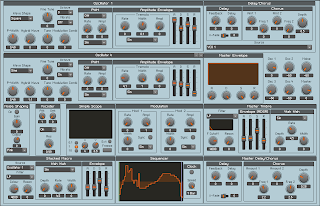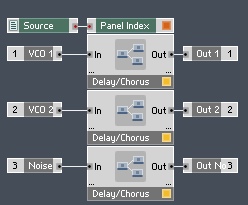As a final thought of the project, it was successful because of all
the elements that we intended to implement were worked and could produced the
sound that most subtractive synthesiser could. Since we've already tried to
emulate a different type of the instrument sound as snapshot for our
synthesiser and they were all sounded perfectly fine, therefore proving that
the synthesiser was capable of producing the sounds that most synthesiser users
wanted. This being said as an
improvement we could add more oscillators so it gives the user the option to
produce more complex and interesting sounds. Adding powerful filters that have
a capability that allow the user to choose poles and type of filter could be
interesting. Also with the individual pitch envelope will give more control on the
pitch of the oscillator so the user can create more interesting sound.
Implementing a powerful noise shaping section in the interface could give more
control level e.g when the user create wind instrument it is very useful. We
could also add the reverb effect which allow the user to set unique uneven
diffusion to the spectrum of the sound. And also the interface needs to be
rearranged to make the signal flow more understandable also having less switches
and an attractive graphic design will let the user understand much easier the
signal flow and the way in which the synthesizer work. The vocoder is the
second type of synthesis used in our design which allows the live alteration of
a microphone input carried thru the synthesizer, in order to have a wider range
of voices, more filters should be added to the vocoding process.
Sound synthesis
Friday, 13 December 2013
Final Changes
The end of our project is near so in order to ensure that everything is working properly we had to check every assembled part of the synthesizer and make changes accordingly.
The following changes have been made:
-We changed the depth of the modulation LFO to a value of 2 to give a full vibrato effect
-Added amount fader to all the filter (timbre) envelopes to give the inverting option
-Added level on mixer for the vocoder with a higher gain range because the vocoder tends to by quieter that the actual synthesizer
-Changing the crossfader name of the delay effect from X-fade to Dry/Wet
-Ensured that the pwm(pulse width modulation) is connected to the pulse waveform and works as it should
The following changes have been made:
-We changed the depth of the modulation LFO to a value of 2 to give a full vibrato effect
-Added amount fader to all the filter (timbre) envelopes to give the inverting option
-Added level on mixer for the vocoder with a higher gain range because the vocoder tends to by quieter that the actual synthesizer
-Changing the crossfader name of the delay effect from X-fade to Dry/Wet
-Ensured that the pwm(pulse width modulation) is connected to the pulse waveform and works as it should
Thursday, 12 December 2013
THE TRACK
A good way to try the variety of sounds the synthesiser can produce, it was decided to record an original piece of music.
The synth itself would provide enough sounds which had been saved as snapshots. There are sound like drums which were created mostly with envelopes and white noise, Organs, leads, pads etc. After having a vast arrange of sounds where we can pick from, the next step should be recording the track.
The track itself was purely made with sounds created with the synth, and Reaktor was run on Logic. Going into more detail about the recording process, It was the drums and the bass the first sounds to be recorded, which also helped with the structure of the song. After that, and in order to fill up the track, we had some leads and soft pads. Hard pads would do most of the main melody of the song.
If you hear the track, the snare drum would sound more like a whiplash than like a proper snare. We were not actually trying to have a proper acoustic snare as it would not be appropriated for the style of the song. We achieved the whiplash sound by just modifying envelopes and filters.
The biggest issue on all the process was that logic was crashing all the time as there were many channels with Reaktor running as a plugin. It was then solved out by turning off the plugin on the tracks that had already been recorded and then record the new ones. At the end, each midi channel was recorded on audio tracks.
Thursday, 28 November 2013
Updates and Improvements
Something we worked a lot at was the interface, in order to
be easy to use it has to be clearly labeled and easy to understand. We kept
music and sound related terms to let everybody use it without necessary knowing
synthesizer related terms.
As an improvement we managed to keep the interface as small
as we can, by implementing stacked macros, and we added a few new things to our
synthesizer.
One of them is noise shaping section that is connected to
the effects unit and the VCF, this allows us to start designing a wide variety
of sounds including drums. The noise section allows the user to switch easily
between 3 types of noises: white noise, pink noise which has a 3dB decrease in
amplitude per octave and the color one which is essentially a white noise
shaped with a band pass filter made by adding HPF and LPF.
An update was also made to the filter section for some
reason the 4-pole HP and LF filters were not able to follow the note-pitch
properly so instead of those a 2-pole filter with both capabilities added.
The chorus effect was
at the beginning made only by transposing the fine tuning knobs from both
oscillators, but in order to work, the user had to enable both oscillators, so
we change that by using a proper chorus made with two delays modulated by two
sine oscillators one normal and one inverted, both signals being added
together.
We also added a step sequencer that allows the user to build his own samples, the step sequencer needs a clock that read the information provided by the system and a switch that enables the use to choose between different speeds of playback. The sequencer needs also a table that allows the user to create different patterns and a snap value module to remember the settings on each snapshot.
Sunday, 24 November 2013
GUITAR SOUND EMULATION
What a guitar, harp or piano sound have in common is the short duration of their sound once the key or string is played. The way to achieve a sound like this on reaktor is by using a Hold Envelope whose main function is to shorten the sound.
The first components added on the left hand side are the time controls which then are controlled by the Hold Envelope. Then multiplying the sound generator and the Hold Envelope together, would make the sound short which is ideal in order to emulate any string sound.
Now, to make it sound more similar to a guitar sound, the sound of the oscillator (already shortened) goes attached to an amp/mixer which connects with a simple delay and a low pass filter. All these final steps in order to get a more similar sound to a guitar.
Subscribe to:
Comments (Atom)




